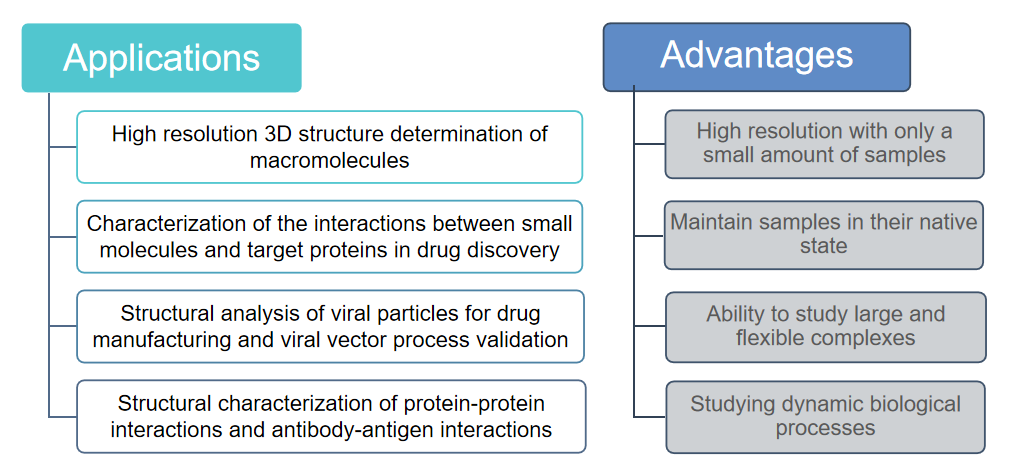
Leave a Message
We will call you back soon!
 Your message must be between 20-3,000 characters!
Your message must be between 20-3,000 characters!
 Please check your E-mail!
Please check your E-mail!

KS-V Peptide has an expert team of structural biologists with strong academic and industrial experience and can offer high-quality structural biology services to pharmaceuticals, biotechnology companies, and research institutions. Our team's expertise and state-of-the-art technology allow us to provide unparalleled services that meet the needs of our clients.

Cryo-electron microscopy (cryo-EM) is a revolutionary technology in the field of structural biology.Combining with 3D reconstruction techniques, it allows acquisition of near-atomic resolution protein structures by rapidly freezing biological samples and using electron beam irradiation. Cryo-EM avoids the need for protein crystallization and is ideal for investigating the structures of membrane proteins (such as ion channels, GPCRs, and transporters) and large protein complexes, which are often challenging to crystallize.

Why do you need cryo-EM?

Why choose our cryo-EM services?
Cryo-EM Workflow

Our Service Guide
| Service item | Process description | Timeline | Deliverables |
| Protein preparation | We can provide construct design, gene synthesis, protein expression, and protein purification based on your demands. | Depends on samples | Quality control data of purified proteins, such as SDS-PAGE, size-exclusion chromatography |
| Negative staining |
Negative stain sample preparation and TEM examination Assess sample homogeneity |
1 week | Sample quality report including 5-10 micrographs of negative stain sample |
|
Negative stain image collection and 2D classification analysis Further evaluate particle size and shape |
2 weeks | Particle analysis data including information on the size and shape of the particles | |
| Sample vitrification |
Rapid freezing sample using FEI Vitrobot system and vitrification optimization with different grids and blotting conditions. Collect a small amount of data to assess the quality of the vitrified samples. |
2-3 weeks | Sample vitrification process report including information on the condition used and data including 2D images to evaluate the quality of the samples. |
| Data acquisition | Data acquisition using Tian Krios 300 kV cryo-TEM | 1-2 weeks | We can provide raw datasets, processed data including 2D class averages, 3D density maps, and 3D structure models. |
| Data processing | Data processing including motion correction, CTF estimation, particle picking, 2D classification, 3D reconstruction, model refinement and model validation | Depends on the data quality and the analysis complexity. | |
| Model building | De novo modeling using high resolution density map |

KS-V Peptide has an expert team of structural biologists with strong academic and industrial experience and can offer high-quality structural biology services to pharmaceuticals, biotechnology companies, and research institutions. Our team's expertise and state-of-the-art technology allow us to provide unparalleled services that meet the needs of our clients.

Cryo-electron microscopy (cryo-EM) is a revolutionary technology in the field of structural biology.Combining with 3D reconstruction techniques, it allows acquisition of near-atomic resolution protein structures by rapidly freezing biological samples and using electron beam irradiation. Cryo-EM avoids the need for protein crystallization and is ideal for investigating the structures of membrane proteins (such as ion channels, GPCRs, and transporters) and large protein complexes, which are often challenging to crystallize.

Why do you need cryo-EM?

Why choose our cryo-EM services?
Cryo-EM Workflow

Our Service Guide
| Service item | Process description | Timeline | Deliverables |
| Protein preparation | We can provide construct design, gene synthesis, protein expression, and protein purification based on your demands. | Depends on samples | Quality control data of purified proteins, such as SDS-PAGE, size-exclusion chromatography |
| Negative staining |
Negative stain sample preparation and TEM examination Assess sample homogeneity |
1 week | Sample quality report including 5-10 micrographs of negative stain sample |
|
Negative stain image collection and 2D classification analysis Further evaluate particle size and shape |
2 weeks | Particle analysis data including information on the size and shape of the particles | |
| Sample vitrification |
Rapid freezing sample using FEI Vitrobot system and vitrification optimization with different grids and blotting conditions. Collect a small amount of data to assess the quality of the vitrified samples. |
2-3 weeks | Sample vitrification process report including information on the condition used and data including 2D images to evaluate the quality of the samples. |
| Data acquisition | Data acquisition using Tian Krios 300 kV cryo-TEM | 1-2 weeks | We can provide raw datasets, processed data including 2D class averages, 3D density maps, and 3D structure models. |
| Data processing | Data processing including motion correction, CTF estimation, particle picking, 2D classification, 3D reconstruction, model refinement and model validation | Depends on the data quality and the analysis complexity. | |
| Model building | De novo modeling using high resolution density map |